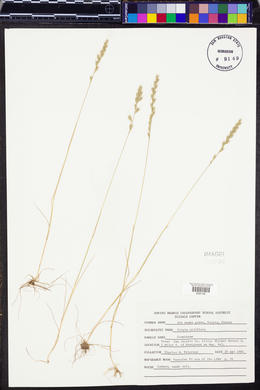Vulpia octoflora
|
|
|
|
Family: Poaceae
Eight-Flower Six-Weeks Grass, more...sixweeks fescue, pullout grass, sixweeks grass
[Diarrhena setacea (Poir.) Roem. & Schult., moreFestuca octoflora var. octoflora , Festuca parviflora Elliott, Festuca setacea Poir., Festuca tenella var. aristulata Torr., Vulpia antofagastensis Parodi] |
Dr. David Bogler, USDA NRCS PLANTS Database Annuals, Terrestrial, not aquatic, Stems nodes swollen or brittle, Stems erect or ascending, Stems geniculate, decumbent, or lax, sometimes rooting at nodes, Stems caespitose, tufted, or clustered, Stems terete, round in cross section, or polygonal, Stem internodes hollow, Stems with inflorescence less than 1 m tall, Stems, culms, or scapes exceeding basal leaves, Leaves mostly cauline, Leaves conspicuously 2-ranked, distichous, Leaves sheathing at base, Leaf sheath mostly open, or loose, Leaf sheath smooth, glabrous, Leaf sheath and blade differentiated, Leaf blades linear, Leaf blades 2-10 mm wide, Leaf blade margins f olded, involute, or conduplicate, Leaf blades mostly glabrous, Leaf blades more or less hairy, Ligule present, Ligule an unfringed eciliate membrane, Inflorescence terminal, Inflorescence an open panicle, openly paniculate, branches spreading, Inflorescence a contracted panicle, narrowly paniculate, branches appressed or ascending, Inflorescence solitary, with 1 spike, fascicle, glomerule, head, or cluster per stem or culm, Inflorescence single raceme, fascicle or spike, Flowers bisexual, Spikelets laterally compressed, Spikelet less than 3 mm wide, Spikelets with 3-7 florets, Spikelets solitary at rachis nodes, Spikelets all alike and fertille, Spikelets bisexual, Spikelets disarticulating above the glumes, glumes persistent, Spikelets disarticulating beneath or between the florets, Spikelets secund, in rows on one side of rachis, Rachilla or pedicel glabrous, Glumes present, empty bracts, Glumes 2 clearly present, Glumes equal or subequal, Glumes shorter than adjacent le mma, Glumes awn-like, elongated or subulate, Glumes 1 nerved, Glumes 3 nerved, Lemma coriaceous, firmer or thicker in texture than the glumes, Lemma 3 nerved, Lemma 5-7 nerved, Lemma glabrous, Lemma body or surface hairy, Lemma apex acute or acuminate, Lemma distinctly awned, more than 2-3 mm, Lemma with 1 awn, Lemma awn less than 1 cm long, Lemma awned from tip, Lemma awns straight or curved to base, Lemma margins thin, lying flat, Lemma straight, Palea present, well developed, Palea membranous, hyaline, Palea about equal to lemma, Palea 2 nerved or 2 keeled, Stamens 1, Styles 2-fid, deeply 2-branched, Stigmas 2, Fruit - caryopsis, Caryopsis ellipsoid, longitudinally grooved, hilum long-linear. Cronquist et al. 1977, FNA 2007, Gould 1980, Kearney and Peebles 1969 Common Name: sixweeks fescue Duration: Annual Nativity: Native Lifeform: Graminoid General: Small annual grass, 15-30 cm tall; stems solitary or loosely tufted, erect, slender. Vegetative: Blades narrow, 1-2 mm wide, 2-10 cm long, the margins rolled upward; sheath smooth to puberulent; ligule 0.5 mm long. Inflorescence: Narrow panicle, 2-10 cm long; spikelets 6-8 mm long, 5-13-flowered; lower glume 3-5 mm long, lance-shaped, 1-nerved; upper glume 3-5 mm long, lance-shaped, 3-nerved; lemma 4-5 mm long, firm, lance-shaped, smooth or rough-textured, with an awn 3-5 mm long; disarticulation above the glumes and beneath the florets. Ecology: Found on sterile, rocky, open ground below 6,500 ft (1981 m); flowers May-July. Distribution: Native to much of N. Amer and in every state in the US; south to c MEX and in S. Amer. Notes: Annual grass varying in size from very small to ca. 30 cm, possessing 5 or more imbricated florets per spikelet, each with an awn. Var. octoflora is told apart by its smooth lemmas, while var. hirtella has scabrous to pubescent lemmas. Schismus barbarus and Schismus arabicus superficially resemble this species, and can grow in similar habitats. A hand lens is handy in distinguishing the species; V. octoflora has awns on all the lemmas, while Schismus lack awns but have glumes with hyaline (partly transparent and whitish) margins and tips, giving the spikelets a green-and-white striped look. Ethnobotany: Unknown Etymology: Festuca is Latin for grass stalk or straw, while octoflora is Latin for 8-flowered. Synonyms: Festuca octoflora Editor: SBuckley 2010, FSCoburn 2015, AHazelton 2015 Slender, decumbent to erect annual 1-6 dm, glabrous or hairy; blades flat or involute, setaceous, 0.5-1 mm wide; infl slender, 3-20 cm, with a few ascending or rarely spreading branches; spikelets flattened, with 5-11+ fls; first glume subulate, 1- veined, 1.7-4.5 mm, the second lanceolate, 3-veined, a fourth longer; florets closely imbricate, the internodes of the rachilla typically 0.5-0.7 mm; lemmas involute, straight, obscurely veined, glabrous or merely scabrous in our vars., soon diverging and exposing the rachilla, the lowest one 2.7-6.5 mm, with an awn 0.3-6(-9) mm; anther 1(-3), 0.3-1.5 mm; grains mostly 1.7-3.3 mm; 2n=14. Dry or sterile soil; Que. and N. Engl. to B.C., s. to Fla. and Calif. (Festuca o.) Two ill-defined vars. in our range: In the mostly southern var. octoflora the spikelets are 5.5-10 mm, and the awn of the lowest lemma is 0.3-3 mm. In the mostly more northern var. glauca (Nutt.) Fernald the spikelets are 4-5.5 mm, and the awn of the lowest lemma is 2.5-6+ mm. Gleason, Henry A. & Cronquist, Arthur J. 1991. Manual of vascular plants of northeastern United States and adjacent Canada. lxxv + 910 pp. ©The New York Botanical Garden. All rights reserved. Used by permission. |
|
|
|




































































































